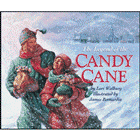
It's time for this week's 'Tis the Season carnival post. I hope you all will join us! We have almost all of our decorations up, except for the tree and we probably won't put it up till Wednesday or Thursday. I can't believe Christmas is this Friday! We are continuing what I think is a common tradition. We all have colds, ugh!
Several years ago, Daddy brought home an animated movie, I think it was called The Legend of the Candy Cane. I enjoyed watching that movie and the story, err, legend, behind the candy cane.


The development of the candy cane took a few hundred years. Before the invention of the modern pacifier, parents used to give their babies unflavored white sugar sticks to suck on. During the 1670's a German choirmaster had the sugar sticks bent into a shepherd's staff and passed out to children attending the Christmas services. This holiday custom spread throughout Europe and fancy canes, decorated with roses, were used as Christmas decorations in many homes. About 1900 the white candy cane received its traditional red stripes and peppermint flavoring. At the same time the legend of the candy cane came into being. According to this legend, a candy maker in Indiana designed the candy cane to tell the true story of Christmas - a story about a virgin giving birth to a shepherd who would give up His life for the sheep.
The most obvious symbolism used in the candy cane is its shape. Turned one way, it looks like a "J" for Jesus. The newborn Lamb of God was named Jesus, meaning Savior, because He was destined to "save His people from their sins". Turned the other way, candy canes remind us of the shepherd's staff. The first people to hear of Christ's birth were shepherds guarding their flocks at night. Jesus called Himself the Good Shepherd and the Bible frequently compares the actions of the Messiah to those of a shepherd searching for his lost sheep, feeding them, gently leading them, and carrying them in his bosom. The sweetness of the candy reminds us that we are fed on the sweet milk of the Gospel of our salvation and peace.
The hardness of the candy reminds us that Jesus is our rock of refuge. In rocky lands like Israel, people often sought shelter from their enemies in the caves or rocky crags of cliffs. Rocks also remind us of the solidness of the promises of Christ who is a precious cornerstone and sure foundation to those who follow Him, but a "stone of stumbling and a rock of offense" to those who reject His gift of peace.
The whiteness of the candy brings to mind the Virgin Birth and the sinless life of Christ. We also are made as pure as the snow through the cleansing action of His blood.
The traditional candy cane has 3 small red stripes to remind us of the soldiers' stripes by which we are healed and a larger stripe which represents the blood shed by Christ on Calvary's tree. Some people say that the 3 small stripes honor the Holy Trinity while the larger stripe reminds us of the one true God. Others claim that the small stripes represent our mini-passions or sufferings and the great stripe symbolizes Christ's Passion. A green stripe is sometimes placed on candy canes to remind us that Jesus is God's gift to us. (Green is the color of giving.)
The peppermint flavor of modern candy canes is said to be similar to hyssop. In Old Testament times, hyssop was associated with purification and sacrifice. During the first Passover celebrations, a bundle of hyssop was used to smear the blood of Passover lambs upon the doorposts of houses so that the Angel of Death would pass over their occupants. Bundles of hyssop were also used to sprinkle blood on worshipers and objects during Mosaic purification rituals. After his affair with Bathsheba, King David appealed to God's mercy crying, "Purge me with hyssop, and I shall be clean; wash me and I shall be whiter than snow". Peppermint reminds us that Jesus is our Passover Lamb. His blood cleanses us from sin and destroys the power of death.
And it came to pass in those days that a decree went out from Caesar Augustus that all the world should be registered. This census first took place while Quirinius was governing Syria. So all went to be registered, everyone to his own city.
Joseph also went up from Galilee, out of the city of Nazareth, into Judea, to the city of David, which is called Bethlehem, because he was of the house and lineage of David, to be registered with Mary, his betrothed wife, who was with child. So it was, that while they were there, the days were completed for her to be delivered. And she brought forth her firstborn Son, and wrapped Him in swaddling cloths, and laid Him in a manger, because there was no room for them in the inn. Luke 2:1-7
See you today and don't forget this Thursday is the last day of the 'Tis the Season carnival. We hope you join us today at One Southern Girl and this coming Thursday over at Pecan Pastures.
All quotes and story is from ChristStory Christmas. Candy picture from Wikipedia. The Legend of the Candy Cane from CBD


2 comments:
Hello, my name is Hannah. I'm a Christian, homeschooled girl and found out about your blog and carnival through the Feminine Farmgirl.
That is such an interesting legand! Although I've heard about the shepherd's staff and the 'J' for Jesus, the rest was totally new to me! It's amazing how many so-called secular things have Christian bases:)
Your Tis the Season Carnival is a great idea--I am going to try and join today.
Blessings and Merry CHRISTmas!!
~Hannah
You stole my post idea for the carnival! ;) Great story! Merry Christmas!
Post a Comment
I ♥ hearing from you!